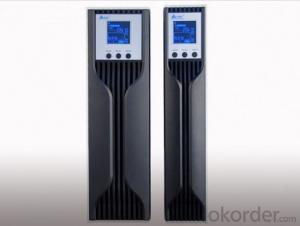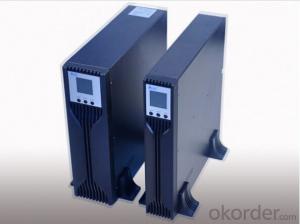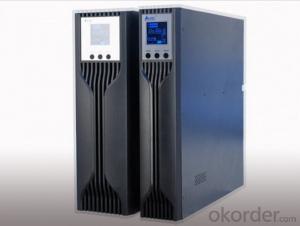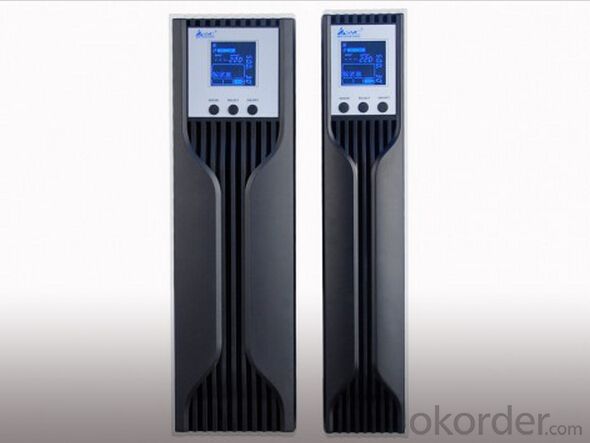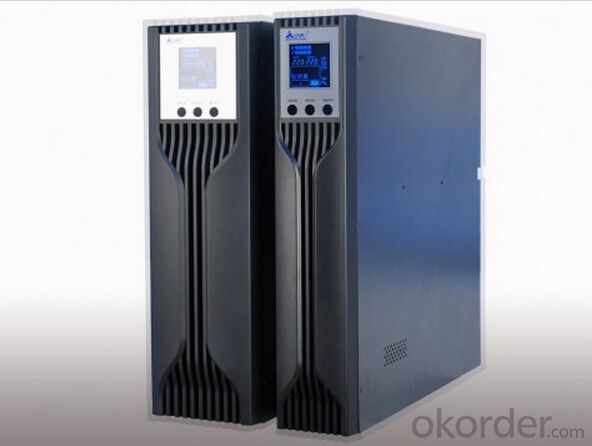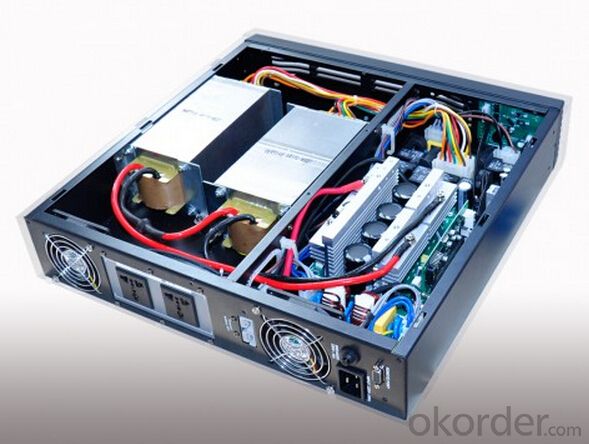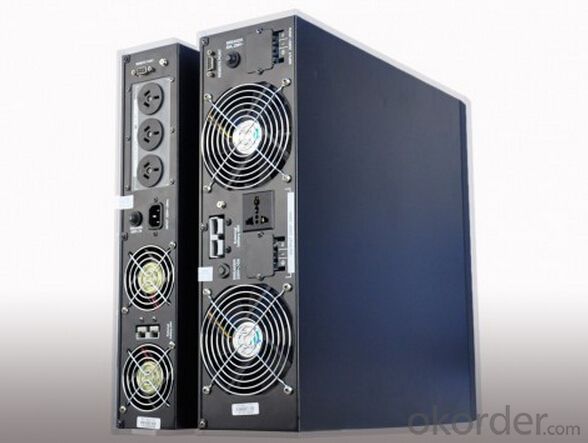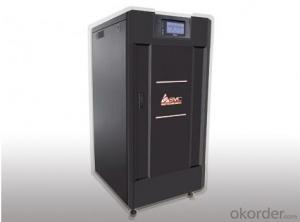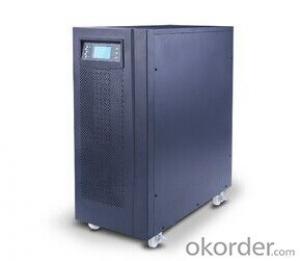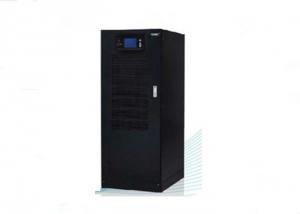Ingeteam Solar Inverter 20~30kVA Online Low Frequency 3 in 3 out Double Conversion UPS
- Loading Port:
- Guangzhou
- Payment Terms:
- TT OR LC
- Min Order Qty:
- 30 unit
- Supply Capability:
- 300000 unit/month
OKorder Service Pledge
OKorder Financial Service
You Might Also Like
20~30KVA Online Low Frequency 3 in 3 Out Double Conversion UPS

1. Wide range of input voltage
The UPS can offer normal and stable service voltage under its input voltage range. When the input voltage is out of its range the machine will switch to battery mode automatically to keep the output power in order to protect the equipment, such as computers, ensure they will not be damaged by the over high or over low voltage, users can continue the operation of equipment for a while or save the data on computers while the power network is abnormal.
2. Wide range of AVR(Automatic voltage regulation)
In the product’s input voltage range and under 3 steps of intelligent AVR function, it can provide a stable output voltage.
3. Automatic self detection when UPS on(LED).
Before the UPS on, red, yellow, blue LED will light up two times by cycle turns, after self detection UPS switch to AC mode/battery mode or working mode.
4. Silence function
In the "battery mode", shortly press the switch to turn off the buzzer. But the battery is about to run out or the load is too heavy, the buzzer sound cannot be muted.
5. Overload protection
In the battery mode, output voltage turn down correspondingly when it is overload, after the capacity of load is lower than the rated power then output voltage will back to rated value, it ensures the UPS will not shut down by abrupt overload which caused by surging current during the computer is working and other equipment is added.
6. Short circuit protection
When the mis-operation caused the load short circuit or computer failure (such as power tube breakdown of switch) cause short circuit, the UPS will shutdown automatically for protection.
7. The low current switch
This UPS adopts low current switch to extend the service life which is longer than conventional battery and high current switch in AC current path.
8. Automatic charging
There are two charging mode, charging time is faster than ordinary charging mode, higher efficiency, and greatly prolonging the service life of the battery.
9. With a bypass output
Independent bypass output socket for external printers or scanners of computer peripherals, with surge protection of the load.
| MODEL | GP33-20-30 | GP33-40-60 | GP33-80-100 | GP33-120-200 |
| Capacity | 20~30KVA | 40~60KVA | 80~100KVA | 120~200KVA |
| Type | Tower | |||
| INPUT | ||||
| Voltage | (208 or 380 or 400 or 480 Vac) ± 20% / 5 wires (3 Lines + Neutral + Ground) | |||
| Frequency | 50 or 60Hz ± 10% Autosensing | |||
| Power factor | 0.98 | |||
| Filter | EMI, RFI | |||
| Dual input | Optional | |||
| OUTPUT | ||||
| Voltage | (208 or 380 or 400 or 480 Vac) ± 20% / 5 wires (3 Lines + Neutral + Ground) | |||
| Frequency | 50 or 60Hz ± 0.1% | |||
| Effciency | AC / AC > 92% | |||
| Trandfer time | 0 ms | |||
| Wave form | Sine wave | |||
| Power factor | 0.9 | |||
| Voltage T.H.D. | < 2% with linear load< td=""> | |||
| Crest factor | 3 : 1 | |||
| Technology | True on-line double conversion controlled by microcontroller | |||
| Overload recovery | Automatically transfer to UPS mode | |||
| Isolation transformer | Inverter mode ( bypass mode is optional ) | |||
| Parallel connection | Parallel connection function is ready (extra PCB is not required ) | |||
| BATTERY | ||||
| Battery type | VRLA ( Valve Regulated Lead Acid ), not included | |||
| DC voltage | 384 Vac | 480 Vdc | ||
| Charging time | 4 hours up to 90% | |||
| Battery detection | self-detect, transfer to battery mode adjustable | |||
| PROTECTION | ||||
Lighting and transient protection | Hotswappable lightning and transient surge suppressor (In:10 Kamp, Up:1.5 Kv, I max : 20 K amp. ) | |||
| Hardware protection | output breaker, battery breaker, bypass breaker; DC fuse, fan, redundant power supply; temperature sensor, EPO (Emergency Power Off), audible alarms etc. | |||
| Software protection | Discharging batteries, battery charge working mode, inverter working mode, emergency power off, manual shutdown, bypass SCR failure, bypass sequence failure, bypass over the lilit, critical overload, batteries exhaustion, low or high output voltage, DC fuse open, 5v power supply failure, 13.5V power supply failure, inverter overvoltage, 200% overload on each line, transfer failure, inverter voltage out of range, over voltage between neutral and ground, UPS on bypass mode, bypass frequency out opf range. | |||
| Bypass | Solid state | |||
| Overload | 125% for 10 min, 150% for 30 sec, 1000% for 16 millisencond. | |||
| EPO | EPO local and / or remote | |||
| Display | LCD, touch screen | |||
| LED's diagram | Included | |||
| Communication | RS232 intellident Slot, modem, SNMP(RJ45) (SNMP adaptive Software is supplied by the producer) | |||
| ENVIRONMENT | ||||
| Elevation | 1.700 m.o.s. 1 without derrating | |||
Temperature & noise | 0℃~40℃ / < 60db @ 1.5m.< td=""> | |||
| Humidity | Non condensate | |||
| PHYSICAL | ||||
| Dimension(mm) | 520*1600*550 | 520*1670*780 | 1000*1860*870 | Ask for information |
Weight (without batteries) | 150 | 300 | 600 | |
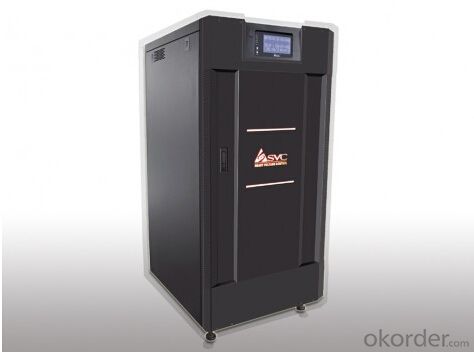
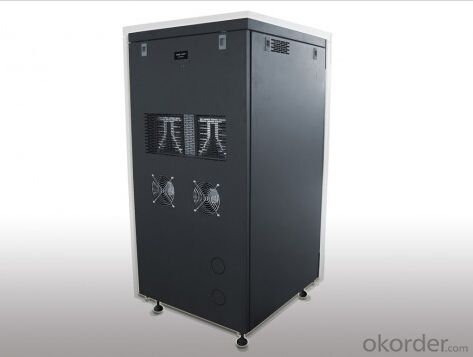
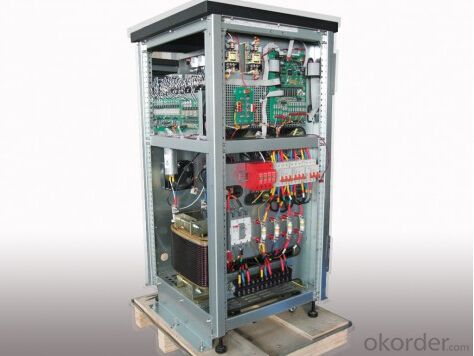

FAQ
1. Where can I buy your products?
You could find our products from dealers or contact our sales team directly. We will provide you with detailed services.
2. How to contact us?
Contact details can be found from website www.okorder.com to contact us. We look forward to providing you with professional services.
3. What is the application field of your products?
Our current GW1500~4600-SS series and GW3000~4600-DS, with the flexible expansion ability and allocation capability, can be used in the small photovoltaic (PV) grid power generation systems of family units as well as the commercial photovoltaic system such as BIPV, BAPV and etc.
4. What kinds of modules do your inventers support?
Our inventers support most of mainstream components and modules in the market. Should you require more details, please do not hesitate to contact our technical personnel.
- Q: Can a solar inverter be used with a solar-powered air conditioner?
- Yes, a solar inverter can be used with a solar-powered air conditioner. The solar inverter is responsible for converting the direct current (DC) produced by the solar panels into alternating current (AC) that can be used to power electrical appliances, including air conditioners. By connecting the solar inverter to the solar panels and then to the solar-powered air conditioner, the AC produced by the inverter can be utilized to run the air conditioner, effectively making it solar-powered.
- Q: What is the role of a galvanic isolation transformer in a solar inverter?
- The role of a galvanic isolation transformer in a solar inverter is to provide electrical isolation between the photovoltaic (PV) array and the inverter's AC output. This isolation is crucial for safety and protection, as it prevents any electrical faults or surges from the PV side from affecting the AC side or the grid. It also ensures that any ground faults or leakage currents are contained within the PV system, minimizing the risk of electric shock and damage to equipment.
- Q: What is the role of a power management system in a solar inverter?
- The role of a power management system in a solar inverter is to efficiently manage the flow of electricity from the solar panels to the grid or the connected devices. It ensures that the power generated by the solar panels is optimized, regulated, and synchronized with the grid's requirements. The power management system helps in maintaining the stability and reliability of the solar inverter system by monitoring, controlling, and adjusting the power flow, voltage levels, and frequency to prevent overloading or underutilization of the solar energy.
- Q: How long does it take to install a solar inverter?
- The installation time for a solar inverter can vary depending on several factors such as the complexity of the system, the size of the inverter, the location of installation, and the expertise of the installer. However, on average, it usually takes around 4 to 8 hours to install a solar inverter.
- Q: How does a solar inverter handle voltage drop in long cable runs?
- A solar inverter compensates for voltage drop in long cable runs by using a technology called Maximum Power Point Tracking (MPPT). MPPT allows the inverter to continuously adjust the operating voltage and current to extract the maximum power from the solar panels. This ensures that even with voltage drop in long cable runs, the inverter optimizes the power output from the panels, ultimately minimizing the impact of the voltage drop.
- Q: What is the role of a solar inverter in net metering?
- The role of a solar inverter in net metering is to convert the direct current (DC) electricity generated by solar panels into alternating current (AC) electricity that can be used to power household appliances or fed back into the electric grid. It ensures that the electricity produced by the solar panels is synchronized with the grid's voltage and frequency. Additionally, the solar inverter allows for the measurement and tracking of the energy generated and consumed, enabling accurate net metering calculations and billing.
- Q: What are the main components of a solar inverter?
- The main components of a solar inverter include the DC to AC inverter, MPPT (Maximum Power Point Tracking) controller, safety features such as circuit breakers and fuses, and monitoring systems for performance tracking.
- Q: Can a solar inverter be used in a floating solar system?
- Yes, a solar inverter can be used in a floating solar system. The purpose of a solar inverter is to convert the direct current (DC) generated by solar panels into alternating current (AC) that can be used to power electrical devices. In a floating solar system, the solar panels are mounted on floating platforms or structures on water bodies. The solar inverter is still required to convert the DC power generated by the panels into AC power that can be used by the electrical grid or connected devices.
- Q: Can a solar inverter be connected to a computer or smartphone?
- Yes, a solar inverter can be connected to a computer or smartphone. Many modern solar inverters come with built-in Wi-Fi or Bluetooth connectivity, allowing users to monitor and control their solar energy system through dedicated apps or web portals on their computers or smartphones. This enables real-time monitoring of energy production, system performance, and even allows for remote troubleshooting and adjustments.
- Q: How do you calculate the maximum power point voltage for a solar inverter?
- To calculate the maximum power point voltage for a solar inverter, you need to determine the voltage at which the solar panels generate the maximum power output. This is done by varying the load resistance and measuring the corresponding power output. The maximum power point voltage is the voltage at which the power output is highest.
Send your message to us
Ingeteam Solar Inverter 20~30kVA Online Low Frequency 3 in 3 out Double Conversion UPS
- Loading Port:
- Guangzhou
- Payment Terms:
- TT OR LC
- Min Order Qty:
- 30 unit
- Supply Capability:
- 300000 unit/month
OKorder Service Pledge
OKorder Financial Service
Similar products
Hot products
Hot Searches
Related keywords
